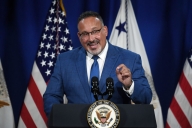You have /5 articles left.
Sign up for a free account or log in.
New data released by the Education Department Wednesday showed 10.8 percent of student borrowers who entered loan repayment in 2015 had defaulted within three years.
That's a slight drop from the previous year's rate of 11.5 percent, driven mostly by lower defaults at public and nonprofit colleges. For-profit colleges saw a slight increase in defaults.
Borrowers go into default on their loans when more than 270 days pass without them making a payment.
Only 12 mostly small institutions faced the loss of federal aid for high default rates, compared to 10 in the previous year. Colleges and universities can lose eligibility for Pell Grants or federal student loans if their cohort default rates exceed 30 percent in three consecutive years, and they can lose access to student loans if that rate exceeds 40 percent in a single year.
But many more schools had high default rates that were not subject to sanctions. The new data included 174 institutions with default rates at or above 25 percent.
Michael Itzkowitz, a senior fellow at the think tank Third Way, said the low number of colleges subject to sanction shows that the cohort default rate is an ineffective tool for restricting aid from going to low-performing institutions.
"Every year, it affects less than 1 percent of student borrowers, 1 percent of institutions and 1 percent of Title IV aid, even though we have data that show a much larger group of institutions where students are struggling to pay down their educational debt," he said.
Debbie Cochrane, vice president of the Institute for College Access and Success, called for stronger federal consumer protections so that fewer borrowers face default.
"The decline in student loan defaults announced today is encouraging, but it is only a part of the story," she said. "Today's rate captures students who default within three years of leaving school, but many more of these students are likely to default in the coming years, especially students who are low-income, African American or attended for-profit colleges. A million students continue to default every year and nearly nine million are now in default."








